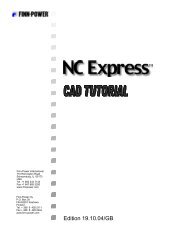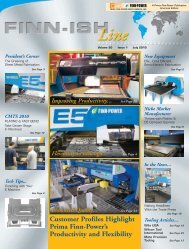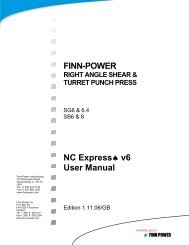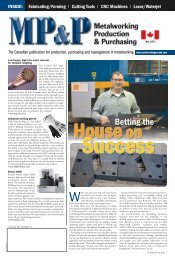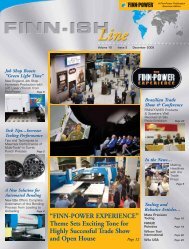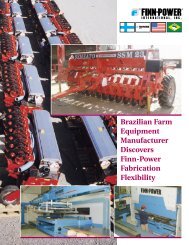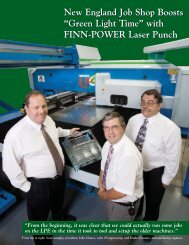Tooling Articles... Advanced Automation Enhances ... - Prima Power
Tooling Articles... Advanced Automation Enhances ... - Prima Power
Tooling Articles... Advanced Automation Enhances ... - Prima Power
You also want an ePaper? Increase the reach of your titles
YUMPU automatically turns print PDFs into web optimized ePapers that Google loves.
am to minimize marking of the underside of the parts. They retract<br />
after use so that the fabricator need not remove the high dies from the<br />
turret afterwards.<br />
2<br />
Consider high-speed tool steels<br />
The quality of the material used to make punches and dies<br />
directly impacts the wear life of the tooling. With the high<br />
speeds punching machines now are capable of reaching, optimal tool<br />
life results when fabricators opt for tooling fabricated from high-speed<br />
tool steels such as M2 and M4. Combined with a fully guided punch<br />
assembly in a high-hit environment, use of high-speed tool steel will<br />
optimize performance.<br />
Another advantage of these tool-steel grades: They have a relatively<br />
high hot hardness and can be coated using a vacuum process, further<br />
improving their wear characteristics. In addition, fabricators can run<br />
these tooling grades in their older machines and enjoy significant toollife<br />
improvements.<br />
3<br />
Say no to slug pulling by carefully setting die<br />
clearance<br />
With the latest generation of high-speed punching machines,<br />
the ability to minimize slug pulling is essential to maintaining<br />
productivity and producing good-quality parts. Die design has a great<br />
deal to do with this. Ideally, aim to have slugs exit the die on punching<br />
rather than pack into the die.<br />
Tabbed dies use protrusions to grip or pinch each slug tightly and hold<br />
slugs in the die. This can very effectively prevent slugs from moving back<br />
into the die. However, the edges of the slug can become deformed<br />
when several slugs are packed into the die at one time.<br />
Plain taper dies are less effective at retaining slugs at high punching<br />
speeds, although their performance improves with the addition of a<br />
slug-vacuum unit on the machine. Note: Fabricators should consider<br />
adding such a unit, regardless of the die design, on any new high-speed<br />
punching machine.<br />
Adding a double taper (with a pinch point at the intersection of the<br />
two tapers) proves particularly effective at avoiding slug pulling. The<br />
slug enters the negative taper and is pushed to the pinch point of the<br />
positive taper, or slightly below, allowing it to fall out.<br />
A note about die clearance: Significant damage can be done to a<br />
punching machine operating at high speed should the punch stick in<br />
the sheet due to inadequate die clearance. Excessive clearance can<br />
result in burring of the sheared edge, and poor hole quality. Correct die<br />
clearance becomes even more critical when punching thicker highstrength<br />
materials (Fig. 1).<br />
4<br />
Tool setup<br />
With the latest generation of punching machines, tool setup<br />
has become a much simpler one-off operation. All of the tool<br />
data, such as overall length, shut height, die penetration and stroke<br />
Fig. 1<br />
By Andrew McCarlie, Applications Engineer<br />
length, is established in the machine control. The control uses these<br />
parameters to calculate optimal punch depth, whether for punching or<br />
forming. Further, the tool-control software parameters then can be set<br />
to different material types and thicknesses for individual tools (Fig. 2).<br />
This is only required to be set up once in the control, relieving the press<br />
operator from having to set tooling parameters for each material and<br />
tooling combination. Note: Accurate, consistent tool lengths are required<br />
to ensure success.<br />
Also, saved turret layouts in the programming system minimize setup<br />
time by grouping jobs together by turret layout, so that multiple jobs<br />
can be run with the same tool setup. These turret layouts are identified<br />
on the program setup sheets. Minimizing setups will optimize tool<br />
performance.<br />
Fig. 2—Tool-control software parameters can be set to different<br />
material types and thicknesses for individual tools. This only is<br />
required to be set up once in the control, relieving the press<br />
operator from having to set tooling parameters for each<br />
combination of material and tooling.<br />
Continued on back cover<br />
PRIMAPOWER.COM 13




